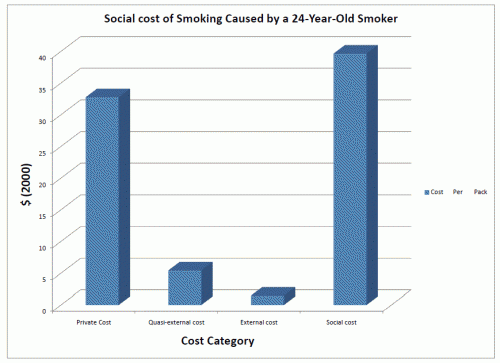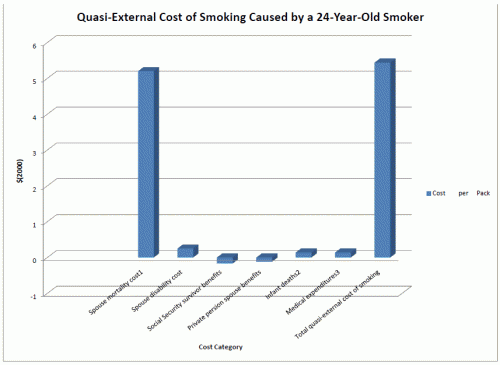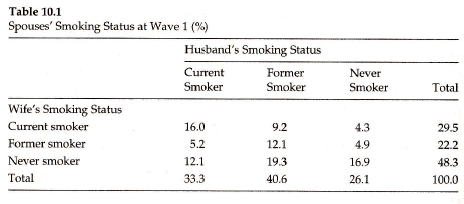This is the third post in a series on the social cost of smoking, estimated to be $40 per pack (2000$). Read the series introduction, and the second post focusing on the private costs of smoking (costs borne by smokers themselves, $33 of the total $40/pack social cost). The cost of smoking was estimated using a life cycle approach that compares the experience of 24 year old smokers in 2000 to that of non smokers, while accounting for the impact of smoking cessation. The posts are based on a book I wrote with Frank Sloan and others (The Price of Smoking, MIT Press, 2004).
 Today’s post focuses on the quasi-external cost of smoking–those costs imposed by smoking on the spouse and children of smokers–which are estimated to be around $5.50/pack, much smaller than the private costs ($33/pack), but larger than purely external ones ($1.50/pack). Typically the sum of private costs (borne by smokers) and external costs (borne by others) is the social cost. We distinguished external costs borne by members of a smokers’ household from others to help illuminate potential policy options to address such costs, as well as for conceptual reasons discussed below.
Today’s post focuses on the quasi-external cost of smoking–those costs imposed by smoking on the spouse and children of smokers–which are estimated to be around $5.50/pack, much smaller than the private costs ($33/pack), but larger than purely external ones ($1.50/pack). Typically the sum of private costs (borne by smokers) and external costs (borne by others) is the social cost. We distinguished external costs borne by members of a smokers’ household from others to help illuminate potential policy options to address such costs, as well as for conceptual reasons discussed below.
By far the largest quasi-external cost is increased spouse mortality ($5.20/pack), which reflects the earlier mortality that spouses of smokers experience (years of life lost were valued at the same $100,000 per life year lost figure used for estimating private mortality costs). There is a small cost of $0.14/pack for the elevated rate of infant death experienced by the children of smokers (life years lost valued at $100,000 each). Similarly small costs were identified for spousal disability ($0.25/pack) and increased out of pocket medical expenditures for household members ($0.14/pack). The quasi-external costs of smoking were reduced by higher receipt of Social Security survivor benefits ($0.17/pack) as well as slightly higher receipt of private pension payments ($0.12/pack); both of these bars dip slightly below the origin in the figure below, showing that spouses of smokers are cross-subsidized by others due to the impact of smoking.
All told, the present value of the quasi-external cost of smoking was $23,407 ($15,985 per female smoker, $29,037 per male smoker), with a total national cost estimate of around $28 Billion dollars for 24 year old smokers in 2000 (table 11.2, p. 254 of the book has more detail). As with private costs, this is an incidence estimate, so each successive cohort of smokers would impose quasi-external costs of this magnitude on their household over the course of their smoking career.
Around 16% of married couples had one current smoker coupled with a never smoker spouse; these are the types of couples in which quasi-external costs were imposed. The table below (p. 234) shows the smoking status identified in wave 1 of the Health and Retirement Survey (HRS),the baseline of a study used prominently in our estimations, to provide a sense of the degree of discordant smoking status among near-elderly married couples at a point in time.
As a rule, economists typically count costs that are borne by family members as internal costs. In doing so, the preferences of all members of the household are assumed to be represented in the decision to smoke. The argument is that even if a particular family member bears a given cost, because of bargaining, costs and benefits are distributed within households in ways that make sense to the family and serve to keep them together. A non smoking spouse who worries about health effects or who doesn’t like the smell of smoke could bargain with the smoking spouse to obtain other concessions. Perhaps the wife smokes and the husband gets to play an extra round of golf per week. Or the smoking spouse agrees to drive soccer car pool.* However, such a bargaining model makes no sense where there are children involved, and we have identified a mortality impact of smoking on the children of smokers. And with marriage dissolution rates of over 50%, the bargains made at a given point in time may not be seen through. With private costs, the calculus of what the benefit magnitudes would have to be to make smoking ‘worth it’ is far more straightforward to think through than is the case with costs imposed on family members. These distinctions lead us to separate quasi-external from the external costs of smoking. However, if you really disagree with this conceptual distinction, you can simply add private and quasi-external costs together.
Several points worth considering:
- The primary quasi-external cost is shortened life of the non-smoking spouse that is due to their spouse smoking. This cost ($5.20/pack) plus the greatly shortened life span experienced by smokers ($20.28/pack, see post 2 on private costs) shows that a majority of the social cost is borne by adults who could be understood to be making informed choices (to smoke and to be married to a smoker). Some will view this as evidence of the need to expand cessation efforts due to the sheer magnitude of harm being imposed because of smoking, while others may view these costs to not be a matter of public policy. This is a value judgment. In economic terms, the first group cannot imagine benefits worth this magnitude of lost life, while the second assumes they must be of sufficient size to justify smoking and even if they are not, it is only a private mistake.
- The cost of shortened life to children living with a smoker while relatively small ($0.14/pack), helps to underline why many reject the idea that the smoking decision is a purely private one. Even if smokers themselves bear more cost, a side effect is to impose cost on others who cannot choose. While infant deaths are rare, and those attributable to smoking are only a subset of a rare event, our life table estimates identified 599 male infant deaths and 409 females deaths due to smoking, which we valued at $100,000 per life year lost discounted at 3% for a total cost of $3.036 Billion (table 11.2, p. 254).
- Couples with discordant smoking status may be good ones to target with smoking cessation efforts. While 16% of couples had one current and one never smoking spouse (12.1% male smoker; 4.3% female), around 6 in 10 persons who were married were former smokers, so it is possible to quit (the sample in question contained persons in their 50s and 60s). The family is likely a key unit in which to target cessation efforts. Various states considering increases in cost share and/or premiums for Medicaid beneficiaries or state employees who smoke should consider targeting cessation resources to families. Particularly families with a smoking spouse and a non-smoking one may be ripe for smoking cessation interventions. The key question for such proposals is what is the goal of the policy?
Tomorrow we will look at purely external costs that smokers impose on society, and we will delve into the cross subsidies of various programs beneath the top level impacts. There aren’t as many value judgments when addressing those costs, as they are clearly a matter of public policy.
Full citation: Frank A. Sloan, Jan Ostermann, Gabriel Picone, Christopher Conover and Donald H. Taylor, Jr. The Price of Smoking. MIT Press: 2004. The Price of Smoking is available as an ebook.
*If this seems a trivial concession, you have never tried to drive from Durham, N.C. to Cary, N.C. for a 5:30pm soccer practice.
update: cleaned up typos


